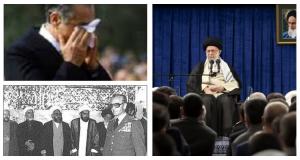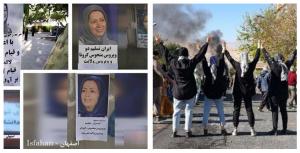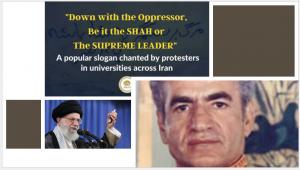(Video) Iran: 100th Day of Uprising, Messages, and Outlooks

Saturday, December 24, marks the 100 days of Iran’s nationwide uprising. For 100 days, Iranian cities are witnessing the bravery of people from all walks of life, especially youth and women. Despite the brutality and the heavy crackdown, protests continued.

Khamenei has repeatedly warned his ilk that any real reform or taking a step backward causes the system to collapse immediately. Shah’s regime started collapsing the day the dictator halted torture and public execution under international pressure.

The presence of organized opposition, a viable alternative (NCRI), and the continuation of the democratic revolution despite the regime’s heavy crackdown foretell a change on the horizon and Tehran’s absolute deadlock in keeping its power.
The regime’s core vulnerability, which animates its strategic orientations, stems from its historical, political, religious, and social illegitimacy at home
The uprising laid bare the face of a moribund and fragile system despite its efforts to portray itself as a regional power, as protests continued despite the regime’s heavy quash.
Protests erupted across the country following the death of a young Kurdish girl in the so-called “morality police” custody. Within hours, protesters started targeting the entire regime, mainly its supreme leader Ali Khamenei, in their slogans.
Although the tragic death of the 22-year-old Mahsa Amini sparked the protests, the powerful wave of dissent that soon spread across Iran stemmed from decades of the regime’s corruption, mismanagement, misogyny, ineptitude, and oppression, which had turned Iran’s society into a powder keg.
A few weeks before the beginning of the anti-regime demonstrations, the ruling theocracy’s Supreme National Defense University published a report, warning authorities that “Three of four Iranians participate in protests.”
The survey, which studied two previous nationwide uprisings in 2018 and November 2019, concluded that “With the continuation of the economic crisis and the sharp increase in the feeling of injustice and inequality in society if uprisings are formed again, nearly 75% of people will participate in the protests.”
The report “Iran after [the Persian Year] 1400” underlined that the two widespread protests in January 2018 and November 2019, along with the sanctions, the regime’s mismanagement of economic impulses, and its policies over the last three decades “promise a deep social change in the near future.”
Therefore, the storm of change began across Iran after nearly two years of calm, mainly due to the regime’s deliberate mishandling of the Covid-19 crisis.
As always, Khamenei unleashed his thugs and resorted to a brutal crackdown. According to reports tallied by the Iranian opposition, the People’s Mojahedin Organization of Iran (PMOI/MEK)1, over 750 individuals have been killed, two detained protesters-Majid Reza Rahnavard and Mohsen Shekari- were hanged, and tens of thousands have been arrested. The latter fact was confirmed by various state-run media, according to a classified report by the Revolutionary Guards (IRGC).
Iranian officials have been making many hollow promises about economic and social reforms, and their pundits abroad make much ado about nothing to portray somehow the conflict between the Iranian people and the regime as merely an economic standoff created due to the foreign sanctions. They have also tried to limit the Iranian people’s demands, especially women, to the abolishment of mandatory veiling.
However, the Iranian people’s slogans, such as “With our without Hijab, onward to the revolution,” or “Poverty, corruption, high prices; we are going to overthrow [the regime]” or “Death to Khamenei,” “Down with the oppressor, be it Shah or leader [Khamenei],” and “our enemy is here; they lie it is the U.S.” have debunked these claims, highlighting the nation’s desire to establish a democratic and secular country.
The clerical regime is indeed bereft of any real solution for Iran’s economic and social crisis. What has caused the country’s economic crunch is the systematic corruption, squandering of the nation’s national wealth on terrorism and obtaining a nuclear bomb, and fortifying the oppressive apparatus.
The regime’s core vulnerability, which animates its strategic orientations, stems from its historical, political, religious, and social illegitimacy at home.
Deprived of a popular base domestically, the regime is sailing too close to the wind. For Khamenei and his regime, human rights violations, supporting terrorism, and pursuing their nuclear weapons program, are vital as oxygen.
Khamenei has repeatedly warned his ilk that any real reform or taking a step backward causes the system to collapse immediately. Shah’s regime started collapsing the day the dictator halted torture and public execution under international pressure.
Religious fascism has learned its lesson from history and wouldn’t repeat Shah’s “mistake” of pausing human rights violations or exporting chaos abroad.
Therefore, the mullahs’ only choice is a brutal crackdown. In fact, the regime’s entire military apparatus is designed to quash uprisings. The IRGC’s primary goal is preserving the regime at all costs, and since the uprisings indeed pose an existential threat to the clerical regime, the organization has established provincial garrisons, with dozens of subordinate bases to react to and oppress anti-regime protests immediately.
In such a situation, the continuation of protests alone confirms they are indeed organized. Many regime officials have acknowledged this fact. “The recent sedition was completely directed and organized to overthrow the state.
Trying to exploit fake seditions, the enemies were looking for street riots, attacks on public and government property,” the state-run Tasnim News Agency quoted Hossein Ashtari, the commander-in-chief of the police force, as saying on December 17.
In a bi-partisan conference on December 17, former U.S. Secretary of State Mike Pompeo also highlighted the fact that the revolution in the making in Iran “is organized, and it’s powerful.
It’s bigger than any one of us three months of powerful, unyielding protests. Uprisings don’t happen randomly. These protests are the result of 40 years of organized opposition to Iran.
One of the major driving forces behind this organization has been the MEK’s Resistance Units Network. This network has spread a culture of defiance in the face of the regime by torching the mullahs’ symbols, posters, and statues.
The Resistance Units have also played a leading role in the current uprising.
Besides, the Iranian Resistance has successfully mobilized the world community to isolate the ruling theocracy further. The MEK’s activities have indeed forced regime officials to warn about its influence on Iran’s society, particularly youth.
On Tuesday, Khamenei rushed to the scene and said: “The youth know little about the MEK. We have not been active enough in this regard. We should’ve better reflected the reality because many of our youth do not know about the MEK.”
His remarks starkly contrast his regime’s incessant efforts in the past four decades to tarnish the MEK’s image both inside and outside the country by wasting billions of dollars on producing the so-called documentaries and movies or writing tens of thousands of articles.
By building and using a network of “friendly journalists” publishing hit pieces against the MEK in foreign media outlets and using its agents posing as “monarchists” or anti-regime activists, religious fascism has been trying to smear the MEK and create fake alternatives.
Iranians have rejected the regime and monarchy by chanting slogans such as “down with the oppressor, be it Shah or the leader.”Therefore, the state-run media have admitted to Tehran’s failure in this regard.
In its article about the MEK on December 22, the semi-official Mashreq News close to Khamenei acknowledged this fact by referring to the trip of former US Vice President Mike Pence to Ashraf 3 in Albania and meeting with the National Council of Resistance of Iran (NCRI)2 President-elect Mrs. Maryam Rajavi3.
“In his statements, the highest-ranking American official in 2016-2020 stroke a deadly blow at the monarchists and supporters of Reza Diba [Pahlavi] and said: ‘The Tehran regime wants to deceive the world into believing that the demonstrators in Iran want to return to Shah’s dictatorship.
But I want to assure you that we will not be fooled by their lies. So let me ask all of you, right here, for the whole world to hear: Do the people of Iran want to replace one dictatorship with another [the Shah]?” the outlet, which is linked to the IRGC Intelligence Organization, added.
The regime has been trying to portray its viable alternative as a “fringe grouplet” with no popular support inside Iran. But the relentless warnings of officials about the MEK’s role in society and the rising trend of youth joining the Resistance Units network make these allegations fall flat.
The presence of organized opposition, a viable alternative, and the continuation of the democratic revolution despite the regime’s heavy crackdown foretell a change on the horizon and Tehran’s absolute deadlock in keeping its power.
Now the time has come for the world community to recognize the legitimacy of the fight and self-defense, of the Iranian people against this evil and terrorist force, to blacklist the regime’s Revolutionary Guards (IRGC) and Intelligence Ministry (MOIS) as the regime’s main crackdown arsenal, to provide 24/7 uninterrupted internet access to the Iranian people and to sever all diplomatic and economic ties with Tehran.
The mullahs will retreat only when faced with a truly vexing strategic choice that impacts the regime’s survival, but not when they are given a platform to deceive and outwit.
Shahin Gobadi
NCRI
+33 6 61 65 32 31
email us here
WATCH NOW: Etemad Online, In an interview with Mohammad Reza Mortazavi, head of the Iran Flour Association, discussed the corruption and plight of workers. at http://www.youtube.com/watch?v=24oUukYthbA

1 https://english.mojahedin.org/a-primer-on-the-history-of-the-peoples-mojahedin-organization-of-iran/
2 https://www.ncr-iran.org/en/about-ncri/alternative/
3 https://www.ncr-iran.org/en/maryam-rajavi/


